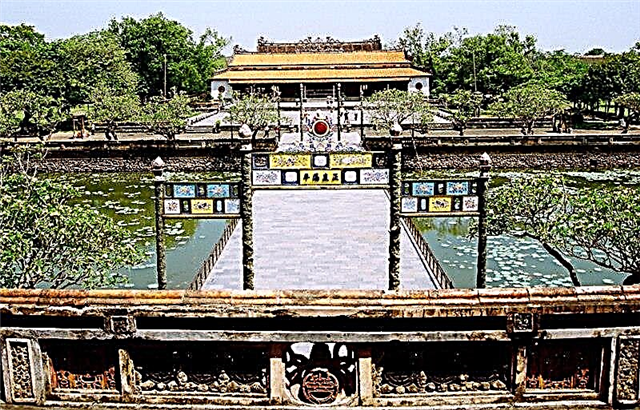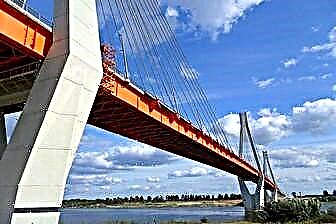Murom is mentioned in "The Tale of Bygone Years" - the most ancient written source that tells about historical events that took place a long time ago on the territory of Russia. For such a small town, there are many attractions here: four monasteries formed from the 11th to the 17th centuries, several Orthodox churches of great architectural value, a couple of noteworthy museums and stunning views of the banks of the Oka.
Murom is the homeland of the well-known mighty hero Ilya Muromets, as well as the Orthodox saints Prince Peter and Princess Fevronia, in whose honor a holiday dedicated to family values was established on July 8. It is safe to say that the city became famous thanks to its famous residents.

The best hotels and hotels at affordable prices.
from 500 rubles / day
What to see and where to go in Murom?
The most interesting and beautiful places for walking. Photos and a short description.
Monument to Peter and Fevronia of Murom
Prince Peter and Princess Fevronia embody the ideal of the Orthodox family and are the patrons of devotion and love. Monuments in their honor already stand in 60 Russian cities. The Murom monument was erected in 2012 next to the Holy Trinity Convent. The composition, consisting of the figures of a prince, a princess and a rabbit sitting at their feet, is fixed on a granite pedestal weighing 7 tons.

Monument to Ilya Muromets
The mighty knight from Russian epics was a real historical figure and came from the village of Karacharovo near Murom. City dwellers are very proud of their fellow countryman and honor his glory in every possible way. In 1999, in the center of Murom, within the Oksky Park, a monument was erected in his honor, which eventually turned into a symbol of the city. The hero is depicted standing on a high pedestal with a sword in his raised hand.

Epic stone
If you enter Murom from Vladimir, then by the road you can see a stone with the face of the hero Ilya Muromets and an inscription in Old Church Slavonic - a quote from the Tale of Bygone Years, which contains the first mention of Murom (862). The block was installed in 1967. Since then, it has become a famous landmark and a must-see stop for wedding corteges.

Murom kalach
Murom kalach is considered one of the city symbols. The monument to the delicacy was erected in 2012 near the central market. It is a 100 kg model about 2 meters high. The monument appeared in Murom thanks to the initiative of a local entrepreneur and was made at his expense. There is a belief that if you come closer to the sculpture, you can feel the warmth and even the smell of fresh baked goods.

1100th anniversary of Murom square
The central city square, the first mention of which dates back to the 16th century. The main architectural building that forms its appearance is the building of the city government, erected in the 1960s in the style of Soviet-style constructivism. There is also a small fountain and a flower alley on the square. During official and national holidays, this place is beautifully decorated with sculptures, arches of ribbons and flowers, ornamental trees.

Moskovskaya street
The street is one of the oldest in Murom - the first stone houses were built here, now considered monuments of urban planning. Today, these mansions continue to house restaurants, shops, hotels and administrative offices. The main attractions are the Church of the Ascension of the Lord, erected in 1729, the city art museum and a park.

The village of Karacharovo
Today Karacharovo is one of the districts of Murom; earlier it was a separate village. The famous Ilya Muromets was born and lived here for some time (before going to the service of the Kiev prince). The first mention of the patrimony dates back to the 17th century - then the land belonged to the family of princes Cherkassky, later they passed to the Sheremetyevs. Karacharovo was included in the city limits in 1960.

Spaso-Preobrazhensky monastery
The men's abode, located on the left bank of the Oka. The first mention of it can be found in the sources of the XI century. She also appears in The Tale of Bygone Years. The monastery flourished during the reign of Ivan the Terrible: the tsar granted the brothers vast lands, ordered the construction of stone churches and endowed the hierarchs with numerous privileges. During the church transformations of Patriarch Nikon, the monastery was one of the pillars of the Old Believers.

Trinity Monastery
The women's monastery, on the territory of which the relics of St. Peter and Fevronia, which makes it a popular pilgrimage site. The monastery was founded in the middle of the 17th century at the expense of the Murom merchant T. B. Tsvetnov on the site of the Old Settlement. The main temple, the Holy Trinity Cathedral, is considered a reference architectural monument of the Russian pattern and stands out for its elegant appearance among all other churches.

Annunciation Monastery
Monastery, which is located in the central part of the city. It was founded by Ivan the Terrible himself in the 16th century on the site of the wooden church of the Annunciation of the Most Holy Theotokos. In 1616, the monastery was plundered by the Poles; it was revived only by the end of the 17th century. The crypt of the main cathedral contains the relics of the venerated Orthodox saints Basil of Murom and the Monk Julian.

Resurrection monastery
Another nunnery in Murom with several centuries of history. According to legend, the monastery was built on the site of one of the palaces of Peter and Fevronia. The monastery existed until 1764, after which it was abolished by the decree of Catherine II. At the same time, all the lands were confiscated in favor of the state, and the monastery churches became parish. Only in 1998 monastic life was resumed here.

Nicholas Embankment Church
An Orthodox church of the 16th century, built in the Moscow Baroque style, or rather, in its "regional" version. The church is located on the banks of the Oka River in the place where, according to legend, St. Nicholas the Wonderworker himself appeared several times. Until 1917, his image, painted in the XIV century, was kept here. Today, the main shrine of the church is the relics of St. Juliania Lazarevskaya.

Church of Cosmas and Damian
According to one widespread belief (no one will remember whether it is fictional or not), the church was erected on the place where Ivan the Terrible set up his tent, passing with the army through the Murom to Kazan. He promised the townspeople that he would build stone temples in case of victory. This is how the Church of Cosmas and Damian appeared. It is an example of white-stone architecture of the mid-17th century.

Ascension Cathedral
The Ascension Cathedral was built in 1729. According to written testimonies, there was already a cold church here. The building is a three-apse five-domed structure with a bell tower in the form of a tent. Services went on until 1920, then the religious institution was closed and the domes removed. The re-consecration of the cathedral took place in 1999, and the bell tower was restored almost immediately.

Murom History and Art Museum
The collection was founded in 1919 at the suggestion of a local resident V.I.Zhadin, a scientist, doctor of biological sciences. The museum exposition occupies four mansions, which are architectural monuments, and consists of archaeological, artistic and historical exhibits. The main branch is located in a building dating back to the 18th - 19th centuries, which previously belonged to the Zvorykin family.

Museum "Bread Room"
The museum appeared in Murom in 2010, the initiator of the creation of the exposition was the private enterprise "Murom Baker".The collection is dedicated to the craft that has flourished in Murom for a long time - the manufacture and baking of various delicacies, primarily gingerbread and rolls. For visitors, the museum conducts interesting thematic excursions, some of which are timed to coincide with national holidays.

Armored train "Ilya Muromets"
An armored train built in 1941–42 for the Red Army. The train was used during the Great Patriotic War. Thanks to its 45 mm armor, he did not receive serious damage during the battles. With his help, several enemy aircraft, artillery batteries and the German armored train "Adolf Hitler" were destroyed. In 1971 "Ilya Muromets" was sent to the parking lot.

Water tower
One of the main attractions of Murom can be considered a water tower, built more than 140 years ago at the expense of the city head A.V. Ermakov. The structure is a three-story brick tower with even rows of arched windows at each level. It is interesting that in 2008, on the day of celebration of the 1146th anniversary of Murom, it started working again and began to pump water from an artesian well.

Oka park
One of the oldest city squares. It was founded in the middle of the 19th century on the site of Oksky Boulevard. Previously, it housed the Murom Kremlin, which was dismantled in the 18th century by order of Catherine II, as well as the Cathedral of the Nativity of God destroyed during the Soviet era. In the middle of the 20th century, attractions were installed in the park. One of the main attractions of the place is the monument to Ilya Muromets.

Murom cable-stayed bridge
The modern bridge over the Oka, built in 2009. It connects Murom and the city of Navashino, which already belongs to the Nizhny Novgorod region. The structure is about 1.4 km long and 15 meters wide. Car and pedestrian traffic is possible here. In 2013, the bridge received the honorary title of the most beautiful bridge in Russia, ahead of even the grandiose pontoons built on Siberian rivers in terms of the number of votes.












